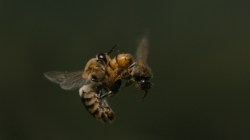
More Than HoneyYep, they’re doing what you think they’re doing.
There’s a new documentary out about bees that you’ll want to see if you’re into the little buggers — and who isn’t? More Than Honey, which is currently showing in New York City, and will travel to theaters around the country in July, is quite possibly the most lavishly filmed insect flick ever.
And let’s face it, bees are the most charismatic — and cinematic — mini-fauna around. Which is frankly a little surprising. After all, with their Darth Vader eyes and weirdly segmented teletubbie bodies, bees are not about to win any beauty contests. Not to mention, they sting, they swarm, and the entirely regimented nature of bee society means that they have got even less personal freedom than the folks in North Korea.
Still, we humans have a predilection for seeing ourselves reflected in bees, finding them industrious, tolerant, devoted, self-sacrificing, tidy … you can fill in the blanks. And did I mention the honey? Bees also pollinate over a third of the fruits and veggies that we eat. (Check out this recent Grist post to see what one supermarket looked like when they removed all of that good stuff from their bins.)
“If bees were to disappear from the globe,” Albert Einstein is said to have mused, “mankind would have four years left to live.” These words, quoted in the film, could be prophetic: Bees are dying in record numbers, for reasons scientists don’t fully understand.
Given the fact that agrochemicals are high on the list of known villains, writer/director Markus Imhoof could have produced an apocalyptic rant about how the chemical-agricultural complex is cynically poisoning our pollinators to hustle a quick buck. But he offers us something better, and more memorable: a work of art and, at moments, breathtaking loveliness. Here’s the trailer:
More Than Honey is not just another finger-pointing green screed. You see, Imhoof is more than the Michael Moore of pollinator death. He is a second-generation Swiss beekeeper whose ambition is less to stoke our outrage than to share his delight in — and fears about — bees.
To accomplish this mission, Imhoof and crew travelled to four continents and interviewed scientists and beekeepers about their odd passion. He introduces us to one mega-beekeeper with 15,000 hives, who hears “the sound of money” in the buzz of his charges in a California almond orchard. And we meet a traditional apiarist deep in the Swiss Alps who struggles to maintain the racial purity of his black-bodied bees.
But where the documentary truly shines is in its close-ups of bees: juveniles hatching from larvae, worker-bees waggle-dancing to tell their mates where the best nectar is, and feeding one another with thin streams of their own barfed-up honey. In one sequence, caught by an airborne mini-camera and slowed down in the film to one-twelfth of its normal speed, drones mate with their queen in flight. These bugs make the sex swing look like child’s play. Check it out:
But all is not sweetness and love in the world of bees. Mites are wiping out beehives worldwide, and so is the chronic overuse of pesticides, including the bee-toxic neonicotinoids which were just banned in Europe. A devilish assortment of fungi and viruses are also spreading unchecked in overcrowded commercial hives. Bees are succumbing to these pathogens in part because their immune systems are already shot to hell by the industrial pummeling of commercial beekeeping.
And then there’s colony collapse disorder, a mysterious condition where bees fly off en masse from the hive never to return. This past year was the worst yet in the U.S., with upwards of half of the commercial hives in some areas dying, forcing beekeepers servicing California’s almond groves to fly in colonies from as far away as Australia.
In More Than Honey, we witness the insects in their death throes coated in the white snow of a nerve-deadening fungicide. We see them crushed by mechanical loaders, and watch their dead bodies being shoveled into a flaming pyre, whole foulbrood-infected hives bubbling in a witch’s brew of wax and charred insects. We also see bees attacked by blood-sucking Varroa destructor mites. Not your usual popcorn-munching fare.
In one scene, sugar water laced with antibiotics is hosed into troughs to feed the bees, whose own nutritious honey has been pilfered from them. Honey is chock-full of essential enzymes, lacking which bees have a hard time fighting off common pathogens. Adding insult to injury, like other domesticated animals, bees are trucked, sometimes for thousands of miles, cramped journeys which leave them feeling shitty — literally: The fastidious insects “hold their potty” for days at a time, we are told, waiting to be unloaded before they relieve themselves.
“Honeybees are not just dying due to pesticides or mites or antibiotics or inbreeding or stress: It’s the sum of all of the above,” Imhoof said in an interview. “The bees are dying because civilization has prospered.”
And it’s not just the way they are being bred and fed and farmed like CAFO cattle, it’s also conditions in the world beyond the hive. Climate change, habitat loss, and the loss of biodiversity are all having a big impact on bees. Domesticated pollinators are arguably the canaries in the coal mine of the ecosystems they depend on. In one haunting scene, migrant workers in an agrochemically ravaged region of Northern China where bees have already vanished from the wild laboriously hand-pollinate blossoms on fruit trees. Now who do you think does it better, the bees or the humans?
But there is one cause for hope that the director latches onto toward the end of the film: the advent of Africanized killer bees. Why should Hollywood’s nightmare swarms be a hopeful sign? Because, unlike their wimpified domestic cousins, killer bees’ immune systems are still fully intact. Sure they get a bit testy at times, and you certainly need to treat them with a healthy measure of respect. But forget what you’ve heard about them. The feral insects make great honey, as John Miller, a bronzed Robert Redford type from Arizona, found out. And no, they won’t come chasing after you unprovoked.
Miller raises the wild bees as best he can, which is not always so well, given that they prefer to nest in inaccessible cliffs rather than in Miller’s premade wooden hives. Killer bees, which escaped years ago from a breeding experiment in Sao Paulo, Brazil, have been moving gradually north ever since — to decidedly mixed reviews in our insect-queasy land.
“Americans are afraid of invaders,” Miller drolly observes. But these invaders from south of the border have got great genes, which may eventually reinvigorate our own flagging bees. Who knows, they may even replace them.
“If I were a gambling man,” Miller says, “I would bet on the survival of the African bee.”



